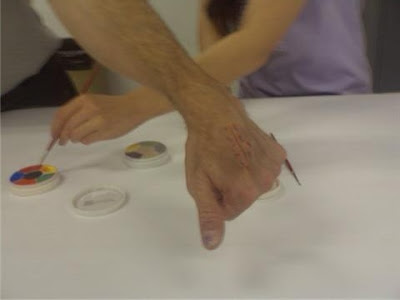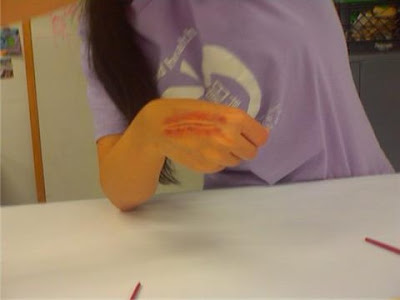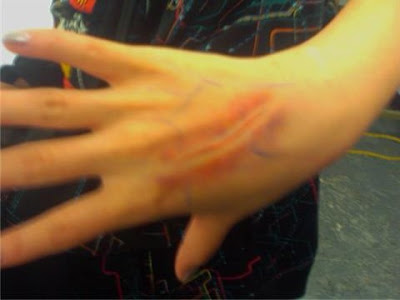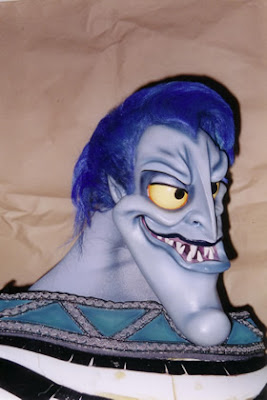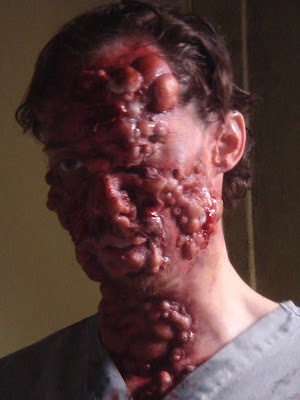So last Monday, class was cancelled due to observation of Columbus Day. Heading into our 2
nd session, we were all under the impression that we were to begin learning scars and bruising from the make-up kits that were going to be issued to us. Low and behold, our Quarterback Carl called an audible as our classmate Kevin had brought along his wife Tam to serve as a model for a life casting demonstration.
A word of safety. I am no way completely trained in these techniques. This blog serves as a record and guide to my lessons. Please consult trained professionals before attempting any of these procedures. These materials and their improper use can cause serious harm. Please read all warnings and directions before using any of these materials. It helps to have the number to Poison Control handy too. Like OHSA says "Safety is No Accident".
When setting your materials and tools (brushes, mixing bowls, etc.) be sure to have a clean area to work in with room to move around. Good ventilation is key too. Be sure all your chemicals are labeled so you know exactly what you poured. You don't want to mix things up in the flurry of activity that will follow.
When you are dealing with a model ask them questions to insure a positive experience for both of you.
1)
Are you claustrophobic? If the answer is yes, then a full pour mold that covers the face is out of the equation. You might be able to proceed with a sectional casting, depending on their level of comfort.
2)
Do you wear contacts? If the answer is yes, they should be removed. As material is applied, it can get heavy on the face and body. Weight = pressure & Pressure = discomfort.
3)
Are there any medical restrictions I should know about? Difficulty breathing, especially through the nose, or other degenerative conditions can prevent the person from sitting for the entire duration of the casting.
Be safe and through as you explain the techniques of application, the timing and above all the necessity for your model to not talk. Communication should be delivered through thumbs up and thumbs down. A neutral expression is desired for the optimum casting. All jewelery should be removed, especially facial piercings. Also all facial hair must be shaved. Better to shave it than yank it.
Make sure your model is comfortable and the job will go
alot smoother.

When applying a bald cap it's important to ensure correct placement. It should be along the hairline and basically frame the face to allow for maximum coverage of the material. Long hair should be slicked back and pulled flat into a pony tail. For this mold we used a latex bald cap, but they also make them in vinyl for those that are allergic to latex. This is important to know, have a vinyl bald cap as a backup in your kit. Make sure you are covered if you're model has latex allergies.
For this basic face cast, the bald cap is extended OVER the ears. When doing a head cast with ears, it's very important to build up a ridge of
derma-wax behind the ears to prevent Undercuts. Undercuts are like a lock to your mold, preventing a smooth and even pull. When casting ears safety steps should be taken to prevent any seepage of materials into the inner ear canal. A small piece of cotton gently inserted into the ear and covered with
derma-wax will do the trick. That's for another head casting entirely though.

Here you can see the bald cap placed on the model. Make sure that the bald cap fits the size of your model. A cap that is too large can be trimmed, but if it tears, it's like a crack in a windshield; it'll just continue to spread until you replace it. The bald cap is glued in place with
Prosaid, a cosmetic adhesive, applied with a small brush, on both the skin and the bald cap. Spirit Gum is the old stand by, but can be more difficult to remove due to its sticky composition. Make sure that your bald cap is secure along the neckline around the ears. A word of caution as you proceed. The cap has the same elasticity as a rubber band, so don't accidentally "snap" your model.

Apply a thin coating of petroleum jelly to the bald cap, but not on the hairline marking. Marking the hairline can be done with a Sharpie marker by following the natural curvature of the hairline. By leaving the marking clear this will transfer to your
algaenate mold, indicating where to stop and start in regard to the scalp. Mark behind the ears as well, since they will be obstructed in the positive (finished piece) of your mold. This simple step eliminates the guess work of forgotten facial symmetry. By covering the bald cap in petroleum jelly, it prevents the material from unnecessarily sticking to the bald cap. Also apply a thin coat to the eyebrows. Don't grease them completely flat as this will cause air bubbles in your mold. With a small brush, petroleum jelly can be applied to the eyelashes like mascara to prevent from sticking as well. A great tip is to outline the model's neck in packing tape from their shirt collar to their skin. This prevents any material from seeping down the front of their shirt. The ladies will love you for this.
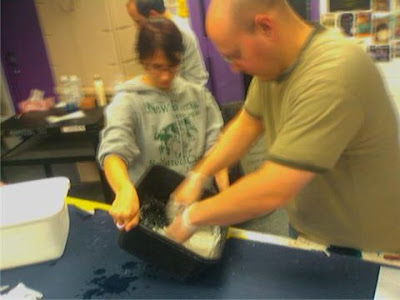
We used a
PGC (
Prostethic Grade Cream)
Ultracal 30 which contains more
algaenate for finer detail. The 30 refers to its work time, meaning you have roughly 30 minutes before it's set and unable to be further manipulated. Here I will refer to a few certain terms. KICK is the gelling stage, when the material begins to solidify. VULCANIZATION is when the material is basically solidified and unable to be worked with further. At this stage you may still feel a bit of heat emanating for the material. This means it still retains moisture. When it is completely CURED it will be solid and cold to the touch.
Think of this material like concrete. How do they build a bridge? They pour it into water and it activates, forming an irreversible bond.
Ultracal, like concrete, is exothermic, meaning it generates a certain degree of heat as chemical bonds are formed. This is why you never apply plaster directly to human skin. It contains gypsum, a exothermic compound capable of burning and causing bodily harm. When the bond is completely formed, the material cools and settles.
Keep this material stored in a dry, cool environment as it begs to attract moisture. Water is the catalyst. You can mix the Prosthetic Grade Cream in a tub with water. Less water mixed in = shorter curing time meaning you will have less time to work with the material before it sets. More water = longer curing time meaning more time to work with the material before it sets. This is important to know as with mold making that materials = time and time = money. You're basically looking for the consistency of pancake batter. It helps to wear gloves (vinyl ones help for those looking to avoid latex allergies) so that your hands can be clean in an instant for whatever pops up. Make sure to have a box handy with your other materials.
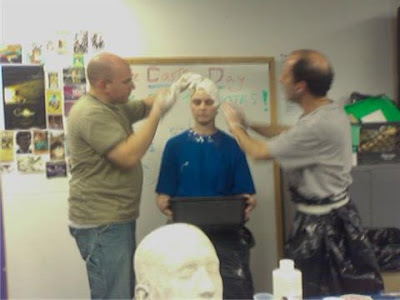
Make sure your model's wardrobe is covered and you're not working in your Sunday best. This will get messy. Cut trash bags make great capes and aprons. Once your mix is at the right consistency, begin applying from the top of the head working downwards. Gravity will make the viscous fluid work in your favor. Hopefully you remembered to ask your model to go to the bathroom before you got to this point. It'll be roughly 30-45 minutes before they're done.
You are only going to be applying the material to the "meridian point", meaning only the front half of the head. Going past this point will create harder mold to pull off of your model. In no way should you attempt to do a FULL head cast if this is your first time undertaking such a task.
Consistently ask how this feels and if everything is
ok for your model. Talk them through it as you apply material to each section of the face. This combats all the odd sensations they're feeling right now. BE ABSOLUTELY SURE that you DO NOT COVER THE NOSE. You are covering the mouth and this is the only way they can breath. DO NOT use cut straws in the nose. This is awkward for them, and poses the risk of you bumping a sharp object into their nasal cavity. Also it can have a detrimental look on your casting. The nose will be the last piece covered with material.
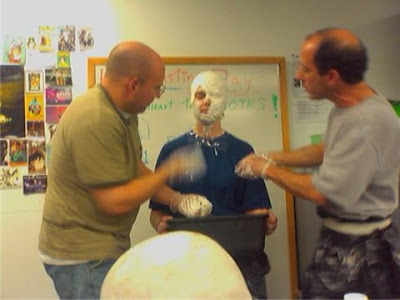
As your model continues to give the thumbs up, proceed at a quick and even pace. Smooth along the eye sockets to flush out any air bubbles. They like to hide in the regions of the mouth too. As the
Ultracal drips along the neckline, catch it in your hand and place right back on top of the head. Now you're maximizing your product rather than just letting it spill on your model and the floor.

At this point the
Ultracal began to kick and quickly vulcanize. Plaster bandages were dipped and wrung through water and applied over the
Ultracal. Using cold water allows for more work time, warm water speeds up the process. This creates a MOTHER MOLD, which is used as an
impressioned mold of stronger material for the mold that sits within it. Think of it as the protective shell that helps keep the shape of the
Ultracal mold. Be sure to check with your model as the plaster will begin to generate heat as it begins to dry.

Here you can see Carl quickly pulling off the mold. The issue that arose was that Tam's left nostril was partially obstructed making her breathing more labored. By consistently asking her level of comfort she indicated that is was uncomfortable to breath and wanted pulled out of the material. This was all done in less than 3 seconds. ALWAYS PAY ATTENTION TO YOUR MODEL!

Here is the mold of Tam's face. Immediately you can see the fine detail the material can capture as well as the hairline marking. Ideally without the forced pull, 6-8 layers of plaster bandages would make up the Mother-mold. This creates a solid form as a base for the "positive" casting.

Here is some closer detail of the pull. You can see some of the distress in the nose area. Now this presented a unique opportunity to the class to see how Carl would handle this situation. If the
Ultracal kept drying, the nose would become a larger problem. By wetting some paper towels and placing them over top, he was able to add a few moments to run to his supply room. There he grabbed some sculpting putty and was able to plug the hole from the reverse side. The other step to this dilemma would be to section off the nose and recast it separately. By using the clay first, he saved himself about 80% of work and the need to recast the model.

Next a small amount of plaster was mixed to pour into the mold. As the
Ultracal dries it also shrinks and can distort the original shape of what was casted. Immediate casting of your positive guarantees optimum results. First apply a thin coat to produce an even distribution and prevent weight distortion. This also helps prevent any air bubbles from simply dumping the mixture in.
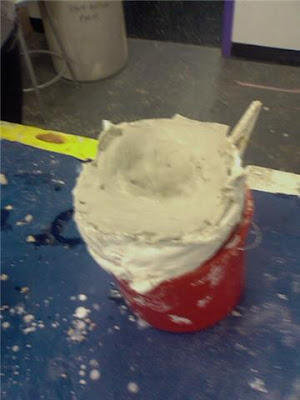
Be sure to secure the edges of your mold together. Clothes pins around the sides will keep them in place at the edges that want to unfurl. As the material cures, you can perform a simple "scratch test". Take a fingernail and see if you can make an indentation. If you can, let it sit. If you try to pull it, it'll come out like wet cake batter.
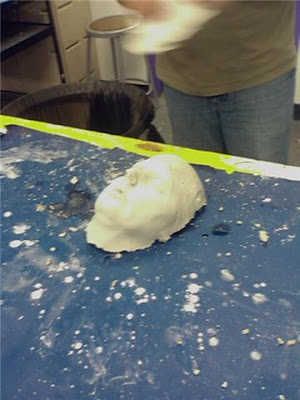
Once it's dry, you can pull your positive! Be careful as the edges can be sharp. You can file them down or use sandpaper to take off the sharp edges. Don't start bleeding now.

Here Kevin takes a hammer and screwdriver and gently "chases" out the undesirable pieces, meaning he's cutting away what he doesn't want in his positive mold. This included the extras pieces that inevitably cast through with the nose and some air bubbles that popped up. It's not every day you can legally take a hammer to your wife's face. From here Kevin can now use molding clay to sculpt directly onto his casting, creating a variety of appliances like custom fit scars, eye sockets, and other distorted fun stuff. You then cast that face to create another mold and pour another positive. That's how you can
create custom fitted appliances, masks, and other fun stuff that will fit the facial structure of your model.
Make sure that your positive is completely dry. If you attempt to use any epoxy it won't stick if it's still exothermic. Basically if it's still warm, there's still moisture in there trying to dry out. To cast a woman you're gonna use about 3/4 of a lb of
PCG and for a man about the full pound. And yes, it is sold by that weight. You can find this online or at most sculpting and art supply stores. For this type of mold you'll use roughly 4 rolls of plaster bandages too. Your brushes and most other beauty supplies can be found at any beauty counter and other supplies (gloves, trash bags, mixing tubs, etc) at your local pharmacy or hardware store.
In regards to cleanup, allow the
Ultracal to dry and it peels right off. A shop vac or broom will sweep up most plaster dust. Use
Detachol,
Bondoff or
Alcone's 244 to help remove the bald cap and the
Prosaid holding it in place. Be gentle and weary of that aforementioned "snap". Pitch anything else in the garbage.
And there you have it, my very first experience with life casting (outside of my own hands). Next week we were promised to be issued our own make-up kits and dive back into scars and bruising. And yes, Tam is completely
ok, and I'm sure willing to be experimented on further by her husband. The joys of matrimony.
 Some face paint, properly applied dots, and bright bold colors. More info can be found by clicking here.
Some face paint, properly applied dots, and bright bold colors. More info can be found by clicking here.





